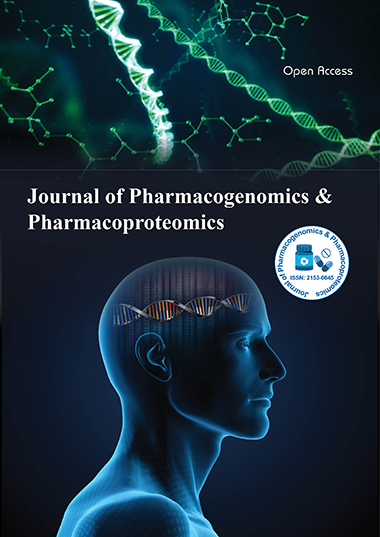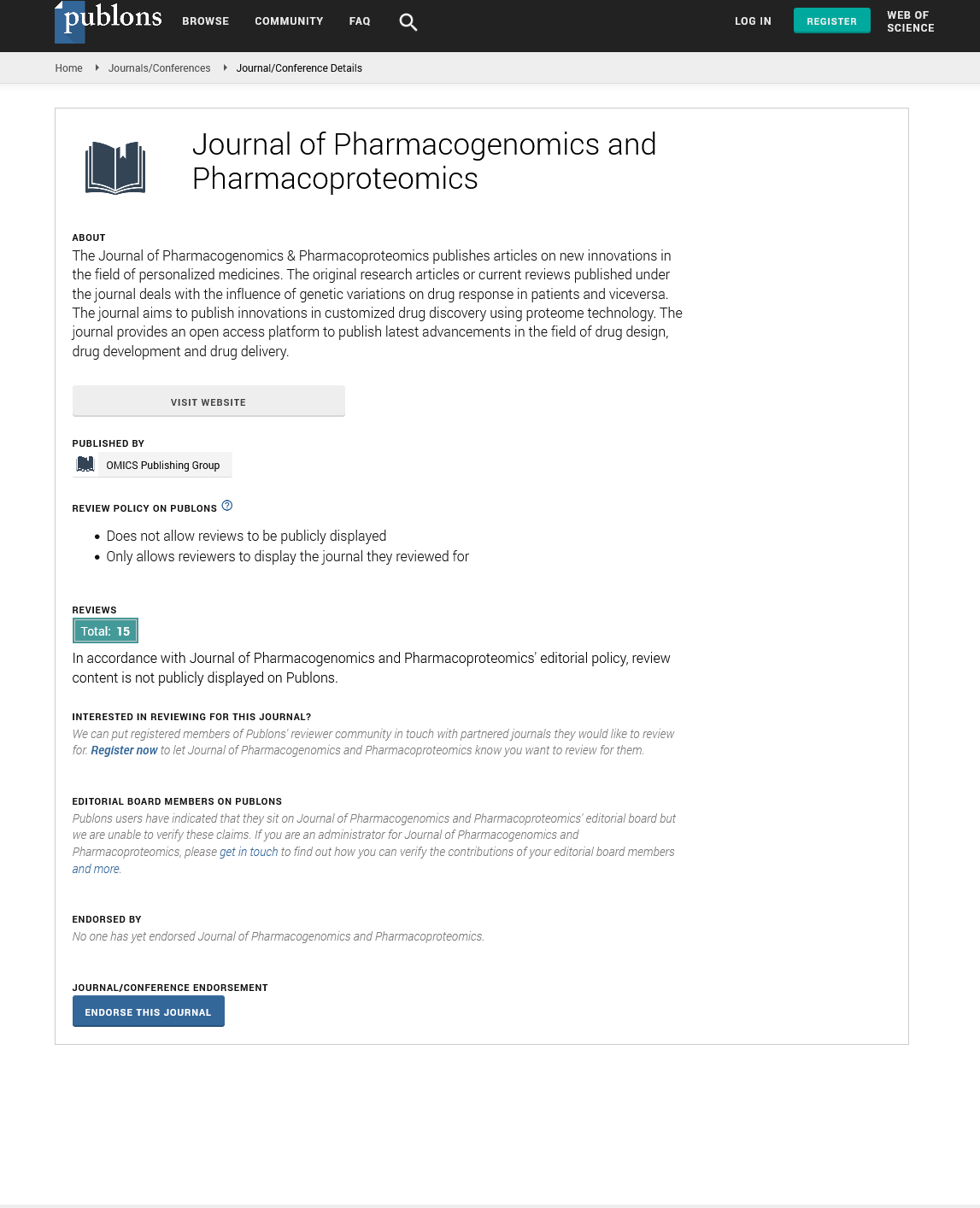Indexed In
- Open J Gate
- Genamics JournalSeek
- Academic Keys
- JournalTOCs
- ResearchBible
- Electronic Journals Library
- RefSeek
- Hamdard University
- EBSCO A-Z
- OCLC- WorldCat
- Proquest Summons
- SWB online catalog
- Virtual Library of Biology (vifabio)
- Publons
- MIAR
- Euro Pub
- Google Scholar
Useful Links
Share This Page
Journal Flyer

Open Access Journals
- Agri and Aquaculture
- Biochemistry
- Bioinformatics & Systems Biology
- Business & Management
- Chemistry
- Clinical Sciences
- Engineering
- Food & Nutrition
- General Science
- Genetics & Molecular Biology
- Immunology & Microbiology
- Medical Sciences
- Neuroscience & Psychology
- Nursing & Health Care
- Pharmaceutical Sciences
Perspective - (2024) Volume 15, Issue 4
Advancing Platelet Proteomics and Lipidomics: Clinical Insights into Thrombotic and Inflammatory Disorders
Received: 25-Nov-2024, Manuscript No. JPP-24-27923; Editor assigned: 29-Nov-2024, Pre QC No. JPP-24-27923 (PQ); Reviewed: 16-Dec-2024, QC No. JPP-24-27923; Revised: 24-Dec-2024, Manuscript No. JPP-24-27923 (R); Published: 31-Dec-2024, DOI: 10.35248/2153-0645.24.15.119
Description
Traditional proteomics has provided valuable insights into platelet function yet understanding the complex interactions between lipids, proteins and cellular structures requires a more integrated approach. The integration of spatial lipidomics with proteomic analysis of platelets offers a promising avenue to assess heterogeneity within platelets at both the molecular and functional levels. This combination provides a detailed view of the lipid and protein pathways involved in platelet activation and function, offering a deeper understanding of their clinical implications. Platelets exhibit significant heterogeneity in both their lipid and protein composition, influenced by multiple factors, including their activation state, aging and interactions with other cells. Spatial lipidomics, the study of lipid distributions in cellular or tissue contexts, provides important insights into how lipids are spatially organized and how their distribution affects platelet behavior. Lipids are involved in various cellular processes such as membrane integrity, protein trafficking and signal transduction. In platelets, the specific distribution of phospholipids, sphingolipids and cholesterol is pivotal in modulating receptor activity, enzyme function and platelet aggregation.
Proteomic analysis, on the other hand, has been used to identify and quantify the numerous proteins involved in platelet activation and function. Platelets contain a wide array of proteins, including integrins G-protein coupled receptors, enzymes like phospholipase C and signaling molecules like kinases and protein tyrosine phosphatases. These proteins are key mediators of platelet responses to various stimuli, including collagen, thrombin and ADP, leading to platelet aggregation, secretion and clot formation.
The integration of spatial lipidomics with proteomics offers a powerful strategy to study platelet function, particularly in understanding how lipid and protein compositions work together to regulate platelet activation and signaling pathways. By coupling lipid and protein profiles with spatial mapping, researchers can identify how specific lipids and proteins interact within different regions of the platelet. For example, lipid rafts, micro domains enriched in cholesterol and sphingolipids, are involved in the aggregation of signaling proteins and receptor clustering, facilitating the activation of downstream signaling cascades. Mapping these lipid-protein interactions spatially can provide insights into how platelets respond to different stimuli in vivo.
Heterogeneity in platelet function is often reflected in changes in lipid and protein composition under various pathological conditions. In diseases such as cardiovascular disease, diabetes and autoimmune disorders, platelets exhibit altered lipid and protein profiles. For instance, in atherosclerosis, platelet activation and aggregation are enhanced and platelets display an increased expression of inflammatory proteins. This leads to an increased risk of thrombosis. Similarly, in diabetes, platelets tend to have higher levels of prothrombotic proteins, such as Pselection and altered lipid composition, contributing to the development of micro vascular complications.
Spatial lipidomics and proteomics can help identify the specific lipid and protein markers associated with these conditions, providing diagnostic or prognostic biomarkers that could be used for personalized treatment strategies. By assessing the spatial organization of lipids and proteins in platelets, researchers can predict how changes in lipid and protein distributions may contribute to platelet dysfunction in disease. This approach can provide a deeper understanding of the molecular mechanisms behind platelet-related diseases and identify potential targets for therapeutic intervention. In the context of clinical applications, the ability to map lipid and protein pathways in platelets holds promise for developing novel diagnostic and therapeutic strategies. For instance, identifying specific lipid and protein markers of platelet activation could aid in the early diagnosis of thrombotic disorders or inflammatory conditions. Moreover, by understanding how lipid-protein interactions regulate platelet function, it may be possible to develop targeted therapies that specifically modulate these pathways to prevent excessive platelet activation without compromising haemostasis. This is particularly important in conditions such as cardiovascular disease, where the balance between preventing clot formation and avoiding excessive bleeding is critical.
In terms of therapeutic interventions, the modulation of platelet lipid and protein pathways offers a novel approach to treatment. Lipid-modifying therapies, such as statins, are already in use for their cardiovascular benefits, primarily due to their effects on cholesterol metabolism. However, understanding how different lipid species interact with platelet signaling proteins could open new avenues for targeted lipid therapies to modulate platelet function more precisely. Additionally, targeted proteomic therapies could be developed to specifically block or activate key platelet signaling proteins involved in disease processes, providing a more tailored and effective approach to managing thrombotic disorders.
Furthermore, spatial lipidomics and proteomics could help predict how individual patients will respond to certain therapies. Personalized medicine, which takes into account an individual's unique genetic, lipid and protein profiles, is increasingly becoming a standard in clinical practice. By combining lipidomic and proteomic analyses with clinical data, it may be possible to predict which patients are at risk for adverse drug reactions or who are most likely to respond to specific treatments. This could lead to more personalized and effective treatment strategies that minimize side effects and improve patient outcomes. Challenges in translating spatial lipidomic and proteomic platelet analysis into clinical practice is the complexity of the techniques involved. Both lipidomics and proteomics require high-throughput technologies, such as mass spectrometry and chromatography, which can be expensive and require specialized expertise. Furthermore, the data generated from these techniques are vast and complex, necessitating advanced bioinformatics tools for analysis and interpretation. Nevertheless, the rapid development of new technologies and the increasing availability of advanced computational tools are making it easier to integrate lipidomic and proteomic data and apply them to clinical settings.
Citation: Gaafar F (2024). Advancing Platelet Proteomics and Lipidomics: Clinical Insights into Thrombotic and Inflammatory Disorders. J Pharmacogenom Pharmacoproteomics. 15:119.
Copyright: © 2024 Gaafar F. This is an open-access article distributed under the terms of the Creative Commons Attribution License, which permits unrestricted use, distribution, and reproduction in any medium, provided the original author and source are credited.

